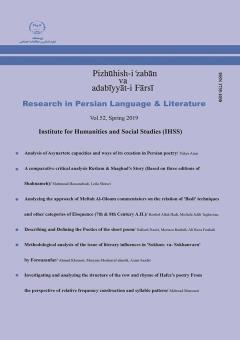-
-
List of Articles
-
Open Access Article
1 - Investigating and analyzing the structure of the row and rhyme of Hafez's poetry From the perspective of relative frequency construction and syllable pattern
Mehrzad Mansouri -
Open Access Article
2 - Describing and Defining the Poetics of the short poem
Nafise Nasiri morteza rashidi alireza fouladi -
Open Access Article
3 - A comparative critical analysis Rustam & Shaghad's story (Based on three editions of Shahnameh)
محمود حسن آبادی لیلا شیرازی -
Open Access Article
4 - Analysis of Asynartete capacities and ways of its creation in Persian poetry
یحیی عطائی -
Open Access Article
5 - Analyzing the approach of Meftah Al-Oloum commentators on the relation of 'Badi’' techniques and other categories of Eloquence (7th & 8th Century A.H.)
ruhollah hadi مصطفی جلیلی تقویان -
Open Access Article
6 - Methodological analysis of the issue of literary influences in'Sokhan- va- Sokhanvarn' by Forouzanfar
Ahmad khatami Maryam Mosharraf-o-lmolk azam saadat
-
The rights to this website are owned by the Raimag Press Management System.
Copyright © 2017-2025







